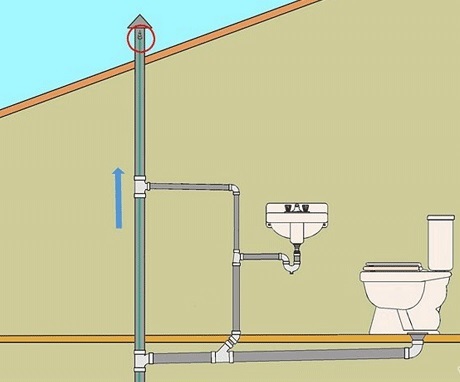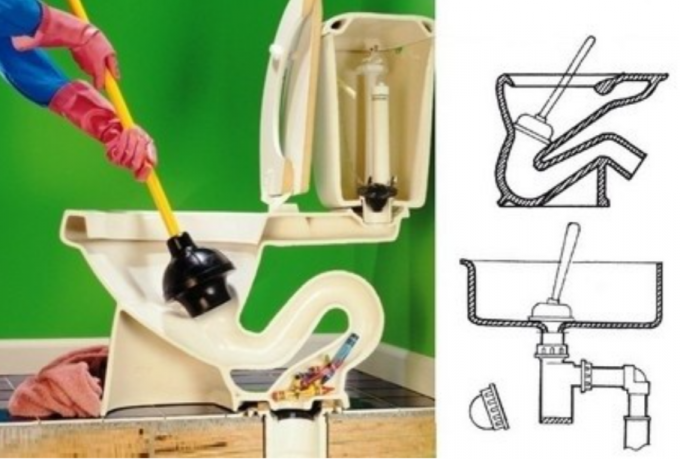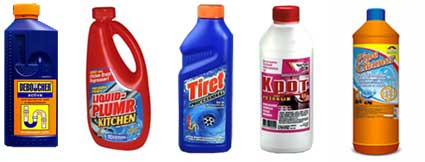- Фактора, которые могут повысить уровень воды
- Вентиляционное отверстие засорено
- Очистите вентиляционное отверстие
- Разбейте засор с помощью туалетного шнека
- Очистите туалет механическими приспособлениями
- Пробивка вантузом
- Химические средства для очистки унитаза
- Щелочные химические средства
- Кислотные химические средства
- Чего не следует делать при засоре унитаза?
- Вывод
Ваш унитаз может вас по-разному удивить, но самое ужасное – это повышение уровня воды после смыва. Если вы заметили, что вода в унитазе при смыве поднимается слишком высоко, вы должны быстро отреагировать, чтобы избежать перелива.
Самая важная задача – определить причину, по которой уровень воды так сильно поднимается. Это может быть частичное засорение унитаза, неисправная система или мусор в вентиляционном отверстии , засор. Каждая проблема требует разного подхода, поэтому продолжайте читать, чтобы узнать, как предотвратить переливание воды в унитазе.
Фактора, которые могут повысить уровень воды
Главное для вас сейчас – сделать вывод, что в первую очередь привело к повышению уровня воды. К этому могут привести три фактора, поэтому давайте посмотрим, как распознать каждый из них.
Частичное засорение сифона или труб унитаза – наиболее частый источник проблемы. Хорошо то, что вы не имеете дело с полностью забитым унитазом – вы можете это сказать, потому что он все еще может смывать, не переполняясь.
Но опасность все же подстерегает, и вам необходимо прочистить туалет, чтобы предотвратить дальнейшие засорения. Частичное засорение происходит, когда вы смываете предметы, которые не подходят для унитаза. К ним относятся Q-советы , средства гигиены, детские салфетки , игрушки, волосы и т. д.
Около 70% случаев связано с жировыми и мыльными отложениями на стенках канализации, скапливающимися в результате работы посудомоечной машины, ручной мойки посуды, гигиенических процедур, а также скопление волос в сливе.
Жир неоднороден по своей структуре, внешне напоминает желе. Ближе к стенкам он твердый, с наружной стороны – мягкий. Затвердение жировых отложений возникает при попадании в них волос, ниток от одежды и пр. Они активно пропитываются минеральными солями от сточных вод, постепенно уплотняясь. В конечном итоге отходы накапливаются, не позволяя воде стекать в канализацию быстро и без усилий. Когда вы смываете частично забитый унитаз, уровень воды мгновенно поднимается, а затем постепенно понижается. К засору унитаза может привести наслоение или резиновая деталь, которая находится над выпускным отверстием унитаза. неправильный монтаж труб слива при этом уплотнительная резинка попадает частично в трубу и начинает постепенно накапливать мусор.
Жировые пробки сложно удалять. Они характеризуются повышенной устойчивостью за счет регулярного подсушивания и повышения прочности структуры под влиянием сквозняка в системе.
Как правило, основными причинами засоров становятся:
- крупные пищевые отходы;
- полиэтиленовые пакеты;
- предметы женской гигиены;
- крупные куски туалетной бумаги;
- тряпки;
- выскользнувшие из таза со стиркой небольшие вещи;
- упавшие в унитаз детские игрушки и др.
Чаще всего, попавшие в унитаз предметы застревают в гидрозатворе, имеющем проходное сечение меньше, чем у канализационных труб. Кроме того, движение стоков в нем затрудняется из-за характерной S-образной формы, создающей дополнительное гидравлическое сопротивление.
Могут возникать засоры и в характерных местах изменения скорости движения потока – на поворотах отводной трубы, а также в месте ее присоединения к стояку.
В более редких случаях засор может появиться не в самом унитазе или неподалеку от места присоединения его выпуска, а в стояке, который отводит стоки со всех этажей. Если в нем возникнет пробка ниже вашей квартиры, то, стояк будет постепенно наполняться канализационными стоками, пока их уровень не дойдет до вашего этажа. После этого стоки с верхних этажей через канализационные трубы начнут поступать в квартиру – из сливных отверстий в ванной и унитазе начнет появляться зловонная жижа.
Вентиляционное отверстие засорено
Большинство домовладельцев не знают о небольшом вентиляционном отверстии на крыше. Это вентиляционная трубка, которая помогает системе восстанавливать атмосферное давление после смыва, что жизненно важно для вашего туалета.
Если вентиляционное отверстие засорено, стоки потеряют свой потенциал смыва и заставят воду подниматься в унитаз. Что может блокировать вентиляционное отверстие? Он находится на крыше, где собирает падающие листья и другой мусор. Со временем он накапливается и забивает вентиляционное отверстие.
Что делать, если при смыве вода поднимается слишком высоко?

Теперь вы понимаете секрет повышения уровня воды в унитазе, но важнее решить проблему. Вот решение для каждой из трех причин.
Очистите вентиляционное отверстие
Засорение вентиляционного отверстия, так что приготовьтесь к лазанию по крыше. Делайте это очень осторожно, потому что вы будете работать на опасной высоте, закрепите себя достаточным количеством веревок и стоячей платформой.
Эта задача требует помощника, потому что вы будете использовать садовый шланг . Добравшись до крыши, возьмите шланг и протолкните его через вентиляционное отверстие. Вода должна очищать вентиляционную трубу, но также может быть обратный поток из-за мусора.
Если это произойдет, вы можете использовать туалетный шнек, чтобы просверлить вентиляционную трубу и удалить твердые отходы. После этого снова включите садовый шланг, чтобы очистить вентиляционное отверстие без препятствий.
На этот раз он не потечет обратно через вентиляционное отверстие, потому что там нет засора. Когда вы это сделаете, вернитесь в ванную и несколько раз промойте унитаз – вы, вероятно, больше не увидите, как вода в унитазе поднимается после смыва.
Разбейте засор с помощью туалетного шнека
Если поршень не дает ожидаемых результатов, вы можете использовать более сильный инструмент. Туалет бур представляет собой острый металлический провод , который идет глубоко водопроводно – канализационной системы. Его спиральная линия соединяется с длинной ручкой, чтобы вы могли управлять шнеком и толкать его.
Возьмите туалетную змейку и закрутите металлическую спиральную линию против часовой стрелки. Крепко держитесь за ручку и продолжайте вращать ее, чтобы добраться до блокировки. Когда штопор дрели касается засора, он на мгновение останавливается.

Это означает, что вы должны дать ему дополнительный толчок, чтобы преодолеть препятствие. Самое лучшее в шнеках – это то, что они собирают много мусора на выходе, поэтому трубы становятся чище после прочистки.
При необходимости вы можете повторить весь процесс, чтобы убедиться, что стоки не засорены. Однако будьте осторожны при сверлении, потому что шнек острый – он может поцарапать слив, сделать трещины или даже просверлить отверстие в пластиковых трубах.
Очистите туалет механическими приспособлениями
Первый совет – использовать специальный инструмент и прочистить унитаз. Не ждите, пока унитаз очистится сам – это слишком сложно, лучше самостоятельно очистить засорение. К счастью, есть несколько инструментов, которые можно использовать для устранения засоров.
Накачать его с помощью поршня для унитаза
Пора вытащить вантуз унитаза из-под раковины – или из того места, где вы его держали. Поместите чашку поршня над сливным отверстием, убедившись, что инструмент очень плотно закрывает фарфор.
После этого начните накачивать вверх и вниз, нажимая и потянув поршень руками. Не забудьте надеть резиновые перчатки, так как они не повредят руки при погружении. Плунжер образует вакуумное уплотнение, которое заставляет засорение выйти наружу.
Продолжайте надавливать, пока не вытесните все, что вызывает засорение унитаза. Когда засор растворится, вы услышите булькающие звуки из труб. Это знак того, что вы можете снять поршень и позволить воде вытечь из чаши.
Пробивка вантузом
Если же причина засора так и не выявлена, а жидкость, хоть и медленно, но просачивается в слив, воспользуйтесь проверенным методом – прочисткой вантузом.
Вантуз – распространенный подручный предмет, регулярно используемый в домашних условиях. Процесс очистки канализационных сооружений проходит по пошаговой схеме.
Работать с этим инструментом довольно просто:
- Вантуз устанавливается над сливным отверстием так, чтобы резиновая часть полностью его перекрывала.
- Несколько сильных нажимов на ручку вантуза заставляют воздух поступать в слив, под давлением проталкивания мусор.
- Методика подходит для небольших загрязнений. Также она может применяться в качестве профилактики.
 Проталкиванию в канализацию скопившихся в трубе отходов способствует гидравлический удар, возникающий при прокачке вантузом. Эффективность работы напрямую зависит от скорости и силы нажатия. Если после извлечения инструмента вода не ушла, манипуляции стоит повторить. После прочистки нажмите кнопку смыва воды и убедитесь в работоспособности системы. В продаже встречается несколько моделей вантузов: Простой чашеобразный – самый дешевый, эффективен для борьбы с мелкими засорами и прочистки труб в раковинах, но не унитазов.
Проталкиванию в канализацию скопившихся в трубе отходов способствует гидравлический удар, возникающий при прокачке вантузом. Эффективность работы напрямую зависит от скорости и силы нажатия. Если после извлечения инструмента вода не ушла, манипуляции стоит повторить. После прочистки нажмите кнопку смыва воды и убедитесь в работоспособности системы. В продаже встречается несколько моделей вантузов: Простой чашеобразный – самый дешевый, эффективен для борьбы с мелкими засорами и прочистки труб в раковинах, но не унитазов.
Но если же вантуз оказался бесполезен – придется использовать другой метод прочистка тросом.
Химические средства для очистки унитаза
Как прочистить трубы химическим способом. Более современными и менее неприятными являются химические способы очистки труб. Здесь уже не требуется прямого контакта с грязью. Поскольку основной причиной засора являются жировые отложения, на которые налипает всё остальное, то главная задача в том, чтобы растворить и смыть жир. С этой задачей хорошо справляется бытовая химия.
Щелочные химические средства
Щелочные средства наиболее эффективны в борьбе с жировыми отложениями. На поверхности труб образуется жировая плёнка, к ней начинает прилипать всякий мусор. Вырастает пробка. А щелочные средства эту плёнку растворяют, очищая тем самым трубу. Щёлочь растворяет мыльные отложения, волосы, которые часто засоряют стоки из ванных. Такие средства рекомендуются для прочистки пластиковых труб.
Сильнодействующий состав заливается в сливное отверстие раковины на 15 – 20 минут, затем всё промывается сильным потоком горячей воды. При очень сильных засорах выдержку следует увеличить, а при необходимости, повторить процедуру ещё раз. Промывку после выдержки раствора можно дополнить работой вантузом.
Средство рекомендуется применять не только для растворения пробок, но и ежемесячно для профилактической промывки труб.
Кислотные химические средства
Кислотные химические средства лучше работают против органических отложений. Значит, их эффективней применять для прочистки водостока после кухни. Технология использования такая же, как и со щелочными средствами. Но выдержка рекомендуется более продолжительная, несколько часов.
Средства домашней химии позволяют проводить процедуры с максимальной скоростью и комфортом. На рынке множество химсредств для борьбы с отложениями и мелким мусором. Химические специализированные составы изготавливаются в форме:
- порошка;
- геля;
- жидкости.
 К недорогим и доступным отечественным препаратам, устраняющим неприятные запахи, удаляющим остатки жира и еды, расщепляющим волосы, шерсть и нитки, относят Крот. Он изготавливается несколькими независимыми предприятиями и отличается:
К недорогим и доступным отечественным препаратам, устраняющим неприятные запахи, удаляющим остатки жира и еды, расщепляющим волосы, шерсть и нитки, относят Крот. Он изготавливается несколькими независимыми предприятиями и отличается:
- компонентным составом;
- стоимостью;
- временем проведения очищающих манипуляций.
Перечень эффективных препаратов с разной ценой:
- Mr Muscle;
- Sanfor;
- Потхан;
- Tiret;
- Флуп.
Чего не следует делать при засоре унитаза?
При возникновении заторов в унитазе не рекомендуется:
- Заливать в него кипяток, пытаясь растопить засор – это может привести к разрушению керамики, возникновению трещин;
- Использовать промышленную химию и средства, не предназначенные для обслуживания канализации, опасные для экологии;
- Применять самодельные тросы и другие подручные средства, способные нанести вред внутренним поверхностям коммуникаций.
Обращаясь к профессионалам, вы экономите время и силы, а в некоторых случаях и материальные средства. Качественная гидродинамическая промывка полностью восстанавливает пропускную способность всего трубопровода, поэтому повторное возникновение пробок исключено.
Вывод
Если вы имеете дело с высоким уровнем воды в туалете, сначала следует выяснить причину проблемы. Это может быть одна из следующих причин – засор в унитазе, сломанная арматура бачка или засор в вентиляционном отверстии.
Это довольно простой проект , сделанный своими руками , поэтому для такого домовладельца, как вы, это не составит труда!
Часто задаваемые вопросы:
Почему моя туалетная вода поднимается после смыва?
Вода в туалетной воде может подняться после смыва по нескольким причинам. Первая причина – частичное засорение сифона унитаза или труб в ванной. Вторая проблема может заключаться в засоре В-третьих, это может быть забитый дефлектор.
Как исправить высокий уровень воды в унитазе?
Вы можете использовать поршень или туалетный шнековый трос, чтобы разложить засор в трубах. Вам может потребоваться подняться на крышу и прочистить вентиляционное отверстие.












